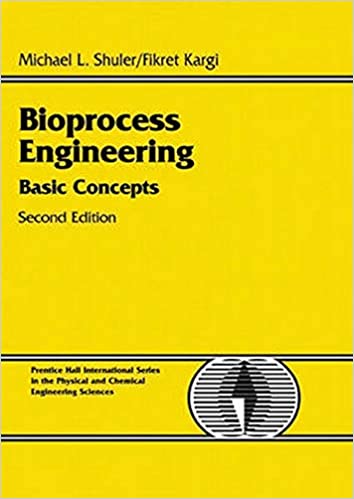
Bioprocess Engineering 2nd Edition by Fikret Kargi,Michael Shuler
Edition 2ISBN: 9780130819086
Bioprocess Engineering 2nd Edition by Fikret Kargi,Michael Shuler
Edition 2ISBN: 9780130819086 Exercise 9
Consider Example 16.1, where we demonstrated that two bacteria competing for a single nu-
trient in a chemostat (well-mixed) could not coexist. Consider the situation where B can ad-
here to a surface but A cannot. Redo the balance equations, where is the surface area
is the surface area
available per unit reactor volume and the rate of attachment is first order in with a rate
with a rate
constant The sites available for attachment will be
The sites available for attachment will be  The attached cells can
The attached cells can
detach with a first-order dependence on the attached cell concentration with a rate con-
with a rate con-
stant of Attached cells grow with the same kinetics as suspended cells.
Attached cells grow with the same kinetics as suspended cells.
a. Without mathematical proofs, do you think coexistence may be possible? Why or
why not?
b. Consider the specific case below and solve the appropriate balance equations for


trient in a chemostat (well-mixed) could not coexist. Consider the situation where B can ad-
here to a surface but A cannot. Redo the balance equations, where
 is the surface area
is the surface areaavailable per unit reactor volume and the rate of attachment is first order in
 with a rate
with a rateconstant
 The sites available for attachment will be
The sites available for attachment will be  The attached cells can
The attached cells candetach with a first-order dependence on the attached cell concentration
 with a rate con-
with a rate con-stant of
 Attached cells grow with the same kinetics as suspended cells.
Attached cells grow with the same kinetics as suspended cells. a. Without mathematical proofs, do you think coexistence may be possible? Why or
why not?
b. Consider the specific case below and solve the appropriate balance equations for


Explanation
a) Since there are 4 equations and 4 unk...
Bioprocess Engineering 2nd Edition by Fikret Kargi,Michael Shuler
Why don’t you like this exercise?
Other Minimum 8 character and maximum 255 character
Character 255


